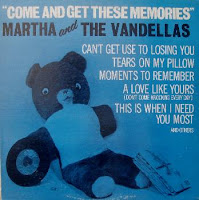 On the cover of the Gordy LP # 902 we find a huge teddy, rather melancholically looking and couched in blue. It is Martha's teddy. Aptly, he appears on the first LP of Martha (Reeves) & The Vandellas, released in June 1963 and entitled »Come And Get These Memories«.
On the cover of the Gordy LP # 902 we find a huge teddy, rather melancholically looking and couched in blue. It is Martha's teddy. Aptly, he appears on the first LP of Martha (Reeves) & The Vandellas, released in June 1963 and entitled »Come And Get These Memories«. To present this vocal group from Detroit is unnecessary, you all know them. Those few that don't will have heard their greatest hits: »Heat Wave« (1963), »Dancing In The Street« (1964), »Nowhere To Run« (1965) or »Jimmy Mack« (1967). But in the summer of '63, they were still on their way to fame. And so was Berry Gordy's Motown Empire.
Martha Reeves was working as secretary of Motown's A&R-man William »Mickey« Stevenson since 1961. It then happened, on June 29, 1962 (or, following Martha's Memoirs, only in July), that she was around when Marvin Gaye had gone into the studio to record »Stubborn Kind Of Fellow« (later released as Tamla # 54068). Alas, the female backing group hadn't shown up, and thus Martha called her friends Ros- alind, Annette and Gloria to come over. The female quartet, without name as yet and assembled for the occasion, provided the backing vocals on Marvin's recording. However, for the being that was as far as it got.
Three months later, in September '62, chance again smiled at the Vandellas-To-Be. The session musicians were about to finish the raw track of the tune »I'll Have To Let Him Go«, while everybody waited for the singer to appear. The song had been given to Mary Wells, the most prominent female voice of Motown's at the time, but now there was no trace of her. Illness, she was to say later, prevented her from coming to the studio, yet others maintain that she didn't like the song and therefore didn't materialize for the recording session. Now, here is a tangle: It was prohibited, following a recent agreement with the labor union of studio musicians, to record a vocal tune without any singer being present in the studio. That is, the agreement was violated if the studio musicians laid down parts of a track with the vocal part being added later. This had become more and more common during the last years. As it happened, an inspector of the union inexpectedly showed up in the studio and the Motown bosses were forced to present him with a singer for the session. Martha was sitting upstairs in the office, and when she was called to the studio she jumped at this chance. The song, featuring Martha Reeves, was then recorded only to save the appearance and to satisfy the inspector. Yet when Mickey Stevenson and Berry Gordy Jr. afterwards listened to the tape with Martha's voice on it they were pleasantly surprised and thought about giving Martha a recording contract. Thus the story of Martha & The Vandellas was about to begin.
 | |||
| First publicity shot 1962 (from Reeves's autobiography) Left to right: M. Reeves, R. Ashford, A. Beard Sterling ... the trio without wigs in an early Afro look! |
The first song of the newly-formed Vandellas, Martha's »I'll Have To Let Him Go« with overdubs added, was released as their first single (Gordy # 7011). It didn't stir any waves, but Motown offered Martha & The Vandellas another chance. And that's how we are approaching the teddy, after all. On January 23, 1963, they recorded another song which was to have considerable success: »Come And Get These Memories« (r&b # 06, pop # 29). The tune was penned by the trio Brian Holland, Lamont Dozier and Edward »Eddie« Holland, then pretty unknown but later coming to fame as Motown's biggest hitmakers. The song was released in February on Gordy # 7014 and laid the foundation for the career of Martha & The Vandellas. Reportedly, Berry Gordy said after having heard the recording for the first time: »That's the sound I've been looking for. That's the Motown Sound!« (quoted in Martha Reeves with Mark Bego: Dancing in the Street. Confessions of a Motown Diva, New York 1994, p. 66). Nelson George wrote about this song:
»There is a joyful buoyancy to the melody and to Reeves' vocal that totally undercuts Eddie's lyric of painful breakup. Annette Sterling's and Rosalind Ashford's backing voices are beautifully arranged, heightening the tune's hummability. It was a decidedly "pop" record, with Reeves' voice mixed way up front and the instruments buried in the mix. It was a catchy record ...«And here is this song, from the same-titled LP:
(N. George: Where Did Our Love Go? The Rise & Fall of the Motown Sound, London 2003, p. 85 f.)
Martha & The Vandellas: »Come And Get These Memories« from the Gordy LP # 902 (1963):
Motown put a lot behind that song and placed several ads in Billboard, which first were to make it known, then to proclaim its success. But they didn't leave it at that. Rather, they took inspiration from the song lines which run:
Lover, you've gone from me and left behind
So many memories
Here's your old friendship ring, I can't wear it no more
Here's your old love letters, I can't read them any more
Lover, you've gone from me and left behind
So many memoriesHere's your old friendship ring, I can't wear it no more
Here's your old love letters, I can't read them any more
Lover, you've gone from me and left behind
Here's that old teddy bear (Come and get it)
That you won for me at the state fair
Here's some old valentine cards (Come and get 'em)
Give them to your new sweetheart ...
Thus the dropped lover sits around with an old friend- ship ring, the love letters, an old teddy bear and the Valentine cards, all reminiscent of former happiness and now only a painful memory. But the said objects also make for handy gimmicks, and so we find them not only on the cover of Gordy LP # 902 but also in an ad published in May '63. The teddy proved to be the most exploitable of these objects, and so it became part of the stage show of Martha & The Vandellas. Martha Reeves tells the story in her autobiography:
»The song itself is about a brokenhearted girl giving back to her boyfriend all of the mementos of their love-gone-bad. On stage I would use a large teddy as a prop. I sang a line about giving back the stuffed animal that had been won at the state fair. When I came to that line, someone would have hand me the teddy bear from the wings. Then I would throw it back when I would reach the line telling the boyfriend to come and get it.« (M. Reeves, Dancing in the Street, p. 66)The ones responsible at Motown, ever shrewd when it came to promoting their acts, immediately recognized the potential of this prop and saw to it that Martha & The Vandellas were to be shown only with a teddy appearing somewhere. And it took more than one teddy to ensure that:

Let me add that apart from the teddy gimmick (which later was used by several other labels, see for example this ad from 1968), Motown had thought of yet another trick of highlighting the charms of the Vandellas. For their stage shows they were given white gloves, and these gloves »... glowed in purple light when we sang 'come on and get it'« (Martha Reeves). Thus the gloves became another recognition sign of the Vandellas and were pictured in a number of Motown ads (click for examples here and here). Without doubt, Motown was already in 1963 at the forefront of what publicity could achieve in the music business and this, nothwithstanding the good sound they were producing, was part of their success. And so it was not Michael Jackson (another Motown disciple) who had invented the »glowing glove«.
* * *
Finally some words about the album »Come And Get These Memories«. Martha Reeves in her Memoirs said the following about this her first LP:»In the first couple months after Christmas, the Vandellas and I completed work on our debut album ... Our first album reflected the kind of music that was popular during that era. It included our cover versions of a couple of popular hits like Little Anthony & The Imperials' "Tears on My Pillow," Andy Williams's "Can't Get Used to Losing You," and a new version of "There He Is (at My Door)" on which I sang lead. The Come and Get These Memories album was not very successful on the charts when it was released ... Original copies of our Come and Get These Memories LP are now considered collector's items. The last one I saw in a record shop was priced at several hundred dollars« (Reeves, Dancing in the Street, p. 80).But, as it goes with debut albums, the Vandellas had not yet found their later style and their future »nitty gritty image« which came with »Heat Wave«, »Dancing In The Street« and several other tunes all classics today. Richie Unterberger is therefore right when, in the All Music Guide to Soul, he put the Vandellas' first album in its proper historic perspective (p. 445): »Their debut album finds the Vandellas in a more limelight and pop- oriented style ..., with some girl group and doo-wop roots still in evidence.« And there is no better evidence for the girl group sound we find on this LP than the song »There He Is (At My Door)«. I personally think it is one of the best of the entire album, and it gains further significance for the fact that it belongs to the earliest recordings of Martha & The Vandellas, recorded back in August 1962 and actually still before they were known officially as »Vandellas«:
Martha & The Vandellas: »There He Is (At My Door)« from the Gordy LP # 902 (1963, mono):






.jpg)










No comments:
Post a Comment